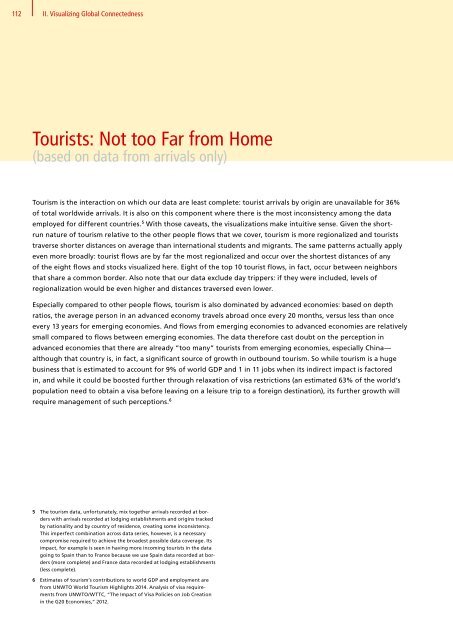DHL Global Connectedness Index 2014
DHL Global Connectedness Index 2014
DHL Global Connectedness Index 2014
- No tags were found...
You also want an ePaper? Increase the reach of your titles
YUMPU automatically turns print PDFs into web optimized ePapers that Google loves.
112 II. Visualizing <strong>Global</strong> <strong>Connectedness</strong><br />
Tourists: Not too Far from Home<br />
(based on data from arrivals only)<br />
Tourism is the interaction on which our data are least complete: tourist arrivals by origin are unavailable for 36%<br />
of total worldwide arrivals. It is also on this component where there is the most inconsistency among the data<br />
employed for different countries. 5 With those caveats, the visualizations make intuitive sense. Given the shortrun<br />
nature of tourism relative to the other people flows that we cover, tourism is more regionalized and tourists<br />
traverse shorter distances on average than international students and migrants. The same patterns actually apply<br />
even more broadly: tourist flows are by far the most regionalized and occur over the shortest distances of any<br />
of the eight flows and stocks visualized here. Eight of the top 10 tourist flows, in fact, occur between neighbors<br />
that share a common border. Also note that our data exclude day trippers: if they were included, levels of<br />
regionalization would be even higher and distances traversed even lower.<br />
Especially compared to other people flows, tourism is also dominated by advanced economies: based on depth<br />
ratios, the average person in an advanced economy travels abroad once every 20 months, versus less than once<br />
every 13 years for emerging economies. And flows from emerging economies to advanced economies are relatively<br />
small compared to flows between emerging economies. The data therefore cast doubt on the perception in<br />
advanced economies that there are already “too many” tourists from emerging economies, especially China—<br />
although that country is, in fact, a significant source of growth in outbound tourism. So while tourism is a huge<br />
business that is estimated to account for 9% of world GDP and 1 in 11 jobs when its indirect impact is factored<br />
in, and while it could be boosted further through relaxation of visa restrictions (an estimated 63% of the world’s<br />
population need to obtain a visa before leaving on a leisure trip to a foreign destination), its further growth will<br />
require management of such perceptions. 6<br />
5 The tourism data, unfortunately, mix together arrivals recorded at borders<br />
with arrivals recorded at lodging establishments and origins tracked<br />
by nationality and by country of residence, creating some inconsistency.<br />
This imperfect combination across data series, however, is a necessary<br />
compromise required to achieve the broadest possible data coverage. Its<br />
impact, for example is seen in having more incoming tourists in the data<br />
going to Spain than to France because we use Spain data recorded at borders<br />
(more complete) and France data recorded at lodging establishments<br />
(less complete).<br />
6 Estimates of tourism’s contributions to world GDP and employment are<br />
from UNWTO World Tourism Highlights <strong>2014</strong>. Analysis of visa requirements<br />
from UNWTO/WTTC, “The Impact of Visa Policies on Job Creation<br />
in the G20 Economies,” 2012.





